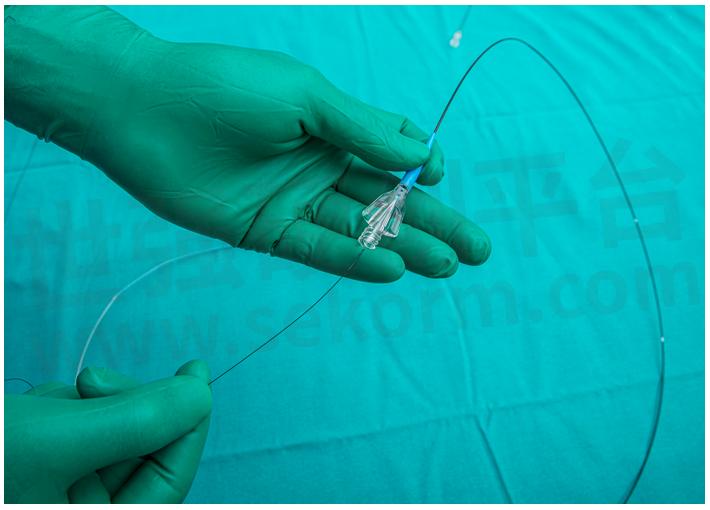Catheter Design and Material Considerations for Sensors

Catheters are indispensable tools in modern medicine, providing a means for diagnosis and treatment of a wide range of conditions.
However, with the ever-present need for more precise and accurate measurements of physiological parameters, SENSORS are increasingly being integrated into catheters.
Adding sensor technology into a catheter is no different than any other piece of medical equipment – it's not simply a plug-and-play process. Rather, catheter design and material considerations for sensors require careful planning and consideration of a variety of key variables that can impact performance and accuracy.

DESIGN CONSIDERATION FOR SENSORS IN CATHETERS
As with any type of catheter – be it one of the different types of Foley catheters or an intracranial catheter – there are some design principles that should always be considered:
Torque: The catheter should be able to withstand the torque generated by guide wire insertion with a guided path through arteries, as well as twisting of the catheter tubing.
Adhesion: The material used for the catheter should resist adhesion to tissue so that it does not cause any discomfort or damage.
Flexibility: The catheter tube should be flexible enough to allow for movement without compromising catheter integrity.
Strength: The material used for the catheter should be strong enough to withstand repeated insertion and removal from the body without any deformation or damage.
Infection prevention: The catheter should be designed with infection prevention in mind, using materials that resist bacteria and other microorganisms.
Kink resistance: The catheter shouldn't get damaged permanently by sharp bends.
But when a sensor enters the equation, there are other issues to consider for the design. Let's take a deeper look at what every catheter manufacturer should be mindful of:
Size
Real estate
Environment
Housing
Lead length
Supply voltage
Calibration accessibility
1. SIZE
This is one of the most basic considerations for every different catheter type.
Put simply, the sensor technology for a catheter needs to be able to fit safely and comfortably within the devices without compromising its integrity or effectiveness. In addition, sensor components must also be compatible with the size of other parts of the device such as tubing, connectors, valves, etc.
2. REAL ESTATE
While you should consider the size of the sensor, there must also be enough space inside the catheter to incorporate it into its design without compromising other features and functionality.
In a catheter, space comes at a premium. The available real estate for a sensor – as well as any other components – must be carefully managed throughout the design and catheter manufacturing process, as there may not be much of it, particularly in miniature devices.
3. ENVIRONMENT
When inserted into the body, catheters face a variety of environmental factors (pressure, temperature, chemical) that directly impact how the device and its components function. For sensors, this means that their materials and design must be resilient to these external – and sometimes, extreme – conditions.
Your design should also consider how the sensor will interact with other components in the device. For example, if the temperature of one component changes due to environmental pressures, it can affect the effectiveness of a neighboring component.
4. LEAD LENGTH
Lead length is the distance from the device body or connector up to where it interfaces with the signal conditioning circuit board. The lead length needs to be long enough for signal capture but short enough so as not to interfere with the movement of other components or parts of the device.
Remember: in general, longer lead lengths can result in higher electrical noise, signal attenuation, and degradation of the signal-to-noise ratio. On the other hand, shorter lead lengths can provide better signal quality and reduce noise interference. However, shorter lead lengths can also result in a higher risk of mechanical damage.
5. SENSOR HOUSING
This consideration applies largely to pressure sensors.
Designed to protect the monitoring device, a sensor's housing provides a durable and reliable barrier to the environment. It also acts as a buffer against environmental factors and vibration.
Inside a catheter, a pressure sensor's housing does even more.
In addition to providing protection from physical elements, it also acts as a shield against electromagnetic interference (EMI) signals passing through the device.
This interference can cause inaccurate readings or incorrect measurements, and thus reduce the accuracy of output from the pressure sensor. In extreme cases, it can even cause malfunctioning of the sensor itself. EMI signals can also disrupt communication between other components in the device.
6. SUPPLY VOLTAGE
Another pressure sensor-centric consideration, a consistent supply voltage is critical for the monitoring devices.
Pressure sensors work by converting the pressure signal into an electrical signal, which is then processed to obtain the pressure measurement. The accuracy of this conversion process is highly dependent on the supply voltage, which must be stable and consistent over time. Fluctuations in the supply voltage can cause errors in the pressure readings obtained from the sensor.
In other words, a sudden spike or decrease in a pressure sensor's supply voltage directly impacts the accuracy and reliability of its readings.
7. CALIBRATION ACCESSBILITY
Be it a MEMS pressure sensor or a medical temperature sensor, a catheter's sensor comes as uncalibrated. To that end, it's on a catheter's manufacturer to fine-tune and test the sensor so that it's able to work properly.
In order to do that, you need to have access to the sensor directly, which means the catheter needs to have a channel or opening so that the user can adjust, test, and calibrate it with ease.
Depending on the type of sensor being used, this approach may necessitate a different opening for each one. Furthermore, access points need to be sealed properly once calibration is complete as any unintentional breach could render the device useless.
MATERIAL CONSIDERATIONS FOR CATHETERS & THEIR COMPONENTS
While there are many material types used in catheters, there is one consideration that cuts across them all: biocompatibility.
Put simply, it’s the material’s property of being compatible with insertion into the body. This is particularly important for catheter manufacturing as the device – and its components – needs to be able to work in its environment without causing any kind of harm or irritation to the patient.
In addition, the materials used for a catheter's components must also be resistant to various environmental factors, such as temperature and pressure, without compromising the sensors' ability to take accurate readings for the same metrics.
Manufacturers must not only consider the compatibility of their materials but also how they interact with one another — especially if they come from different suppliers. This means testing each component individually as well as collectively so that you know what will work best for your design and use case.

- +1 Like
- Add to Favorites
Recommend
This document is provided by Sekorm Platform for VIP exclusive service. The copyright is owned by Sekorm. Without authorization, any medias, websites or individual are not allowed to reprint. When authorizing the reprint, the link of www.sekorm.com must be indicated.


























































































































































































































































































































































































































































































































































































































































































































































































































































































































